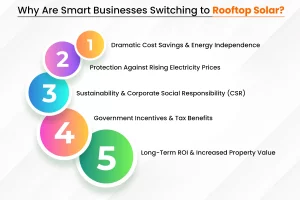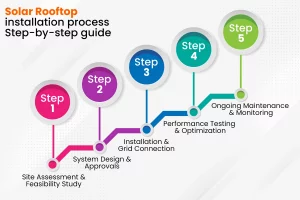Table of Contents
ToggleRooftop Solar Systems for Businesses: Ultimate Guide to Savings & ROI
Introduction: Why Rooftop Solar is a Game-Changer?
Running a business? That electricity bill every month—it’s like a money-eating monster, right? What if you could kick that monster out? Even better—make your electricity instead of buying it from the power company. Rooftop solar isn’t just about saving money. It’s like planting a money tree on your roof. No more worrying about prices going up every year. Your shop, factory, or office gets power, rain, or shine. Plus, you’re helping Mother Earth breathe—no extra effort is needed! If you’re a business owner looking for a smart way to cut costs and boost sustainability, keep reading—this could be the best investment decision you’ll ever make.Rooftop Solar: What Is It & How Does It Work?
Definition:
Rooftop solar is exactly what it sounds like—solar panels installed on rooftops that harness sunlight to generate electricity. Businesses can produce energy instead of relying on traditional power grids, reducing costs and ensuring power stability.Types of Rooftop Solar Systems
1️⃣ On-Grid Solar System: Connected to the main electricity grid. If you generate excess power, you can sell it back through net metering. 2️⃣ Off-Grid Solar System: Completely independent, with battery storage for backup. 3️⃣ Hybrid Solar System: A mix of both, offering grid connectivity + battery storage.🔹 Key Components of a Solar Rooftop Panel System:
✔ Solar Panels: Capture sunlight and convert it into electricity. ✔ Inverters: Convert DC power into AC for business use. ✔ Mounting Structures: Keep panels securely fixed on the rooftop. ✔ Net Metering System: Tracks energy production and consumption. ✔ Battery Storage (for off-grid systems): This saves excess energy for later use.Why are smart businesses switching to rooftop solar?

1️⃣ Dramatic Cost Savings & Energy Independence
Businesses with rooftop panels can cut their electricity bills by 50–90%. Imagine reinvesting those savings into expansion, hiring, or product development instead of paying hefty utility bills. 📊 Example: A 50 kW system can save up to ₹50,000 per month. Over 25 years, that’s ₹1.5 crore+ in savings.2️⃣ Protection Against Rising Electricity Prices
With electricity costs rising year after year, businesses locked into grid power are at the mercy of fluctuating tariffs. Solar gives you a fixed, predictable cost for decades.3️⃣ Sustainability & Corporate Social Responsibility (CSR)
🌍 Consumers today prefer eco-conscious businesses. Companies that invest in solar power position themselves as industry leaders in sustainability, gaining an edge over competitors.4️⃣ Government Incentives & Tax Benefits
🏛️ The Indian government offers massive subsidies and tax incentives to promote solar adoption. This makes installing solar panels more affordable than ever.5️⃣ Long-Term ROI & Increased Property Value
💡 A building with a solar installation becomes more valuable due to lower operational costs. Plus, many businesses recoup their investment in just 3-5 years.What are the popular myths about rooftop solar?
In the general scenario, several misconceptions about rooftop solar are present that we will debunk with a trustworthy source article.1️⃣“Solar doesn’t work on cloudy days.”
Solar panels can still generate electricity on cloudy days. While their efficiency is reduced compared to sunny days, they can still produce significant power by capturing diffused sunlight. Modern solar panels can generate up to 80% of their full capacity even in cloudy weather.2️⃣“Maintenance is too expensive”
Solar panels are designed to be low-maintenance. Once installed, they require minimal upkeep to ensure efficient operation. Occasional cleaning to remove dust and debris and annual inspections are typically all that’s needed. Moreover, many solar panels come with warranties lasting 20-25 years, providing peace of mind for users.3️⃣“It takes too long to recover the cost”
The cost of solar panel installation has dropped dramatically over the past decade, making it more affordable than ever. With solar subsidies, government incentives, and financing options, many homeowners and businesses can install solar with little to no upfront costs. Additionally, the long-term savings on electricity bills can quickly offset the initial investment, often resulting in significant savings over the lifespan of the system. Source:- https://solarurjaa.com/myths-vs-facts-debunking-common-misconceptions-about-solar/
- https://usasolarcell.com/news/2024/10/15/roof-top-solar-myths-busted-our-facts-speak-volumes/
Solar rooftop installation process: Step-by-step guide
 📌 Step 1: Site Assessment & Feasibility Study
🔹 Engineers check roof space, sunlight exposure, and power needs.
📌 Step 2: System Design & Approvals
🔹 Choose the right solar panels, inverters, and mounting systems.
🔹 Secure government approvals and net metering connections.
📌 Step 3: Installation & Grid Connection
🔹 Solar panels are installed and wired to your business’s power system.
🔹 The setup is connected to the local grid for net metering.
📌 Step 4: Performance Testing & Optimization
🔹 Technicians ensure the system runs at peak efficiency.
🔹 Businesses start monitoring power generation via smart apps.
📌 Step 5: Ongoing Maintenance & Monitoring
🔹 Routine cleaning and system health checks for optimal performance.
📌 Step 1: Site Assessment & Feasibility Study
🔹 Engineers check roof space, sunlight exposure, and power needs.
📌 Step 2: System Design & Approvals
🔹 Choose the right solar panels, inverters, and mounting systems.
🔹 Secure government approvals and net metering connections.
📌 Step 3: Installation & Grid Connection
🔹 Solar panels are installed and wired to your business’s power system.
🔹 The setup is connected to the local grid for net metering.
📌 Step 4: Performance Testing & Optimization
🔹 Technicians ensure the system runs at peak efficiency.
🔹 Businesses start monitoring power generation via smart apps.
📌 Step 5: Ongoing Maintenance & Monitoring
🔹 Routine cleaning and system health checks for optimal performance.
Government Subsidies & Financial Benefits
-
PM Suryaghar Muft bijli Yojna
Key Highlights
- Free Electricity: Enjoy up to 300 units of electricity free every month.
- Subsidies: Generous subsidies are available to help cover the costs of solar panels.
- Surplus Power: Sell excess electricity back to the grid and earn extra income.
- Eligibility: Open to Indian citizens with suitable rooftops and valid electricity connections.
-
Grid Connected Rooftop Solar Programme
Key Features
- Objective: To reduce dependence on fossil fuels and promote sustainable energy sources.
- Subsidies: Central Financial Assistance (CFA) is provided to residential consumers. For general category states, the CFA is Rs. 14,588/kW for the first 3 kW and Rs. 7,294/kW for capacities beyond 3 kW up to 10 kW. Special category states receive higher subsidies.
- Implementation: The program is implemented through a national portal and state DISCOMs, making it easier for consumers to apply and receive subsidies.
- Benefits: Besides subsidies, consumers can sell surplus power back to the grid, reducing electricity bills and generating income.
-
State-Level Schemes
Here are some state-level schemes for rooftop solar in India:
1. Rajasthan:
- Subsidy: Offers up to 40% subsidy on the installation cost for residential rooftop solar systems.
- Net Metering: Allows for the excess solar power generated to be fed back into the grid.
- PM Surya Ghar Yojana: Provides subsidies for residential projects, with varying amounts for different system capacities.
- Ease of Approval: Streamlines the approval process for solar rooftop installations.
2. Maharashtra:
- Subsidy: Up to 40% subsidy on L1 prices for residential customers through the Maharashtra Energy Development Agency (MEDA).
- Open Access Solar: Encourages businesses to buy solar energy directly from producers.
3. Tamil Nadu:
- Installed Capacity: One of the leading states with a significant installed solar power capacity.
- Projects: Tamil Nadu Solar Park and industrial areas investing heavily in solar power.
4. Gujarat:
- Incentives: Provide incentives for residential solar setups.
- Pioneer in Solar Energy: Known for pioneering solar energy development in India.
5. Haryana:
- Subsidy: Offers up to 40% subsidy.
- Solar Policy: Encourages both residential and industrial sectors to adopt solar energy.
6. Madhya Pradesh:
- Supports Solar Water Pumps: Offers subsidies for solar water pumps and rooftop solar systems.
- Financial Assistance: Provides financial assistance up to 40% for solar rooftop systems up to 3 kW capacity.
7. Karnataka:
- State-Level Subsidy Program: Available primarily for residential users within the BESCOM service area.
- Net/Gross Metering: It offers net/gross metering options under the Karnataka Government Solar Policy 2014-21.
USPs of Novergy Solar: Why Novergy outranks its competitors?
Novergy Solar is one of the top rooftop solar power companies in India. It provides various solar services, including solar rooftop panels. Here are the key USPs that make Novergy stand out from its competitors. 🌟 18+ Years of Experience—Pioneers in the solar industry. 🔬 Industry-Leading Technology – Certified high-efficiency solar panels. 📦 Comprehensive Solutions – From design to installation and beyond. 💯 Best Energy Output – Higher efficiency than competitors. 📊 Custom Solar Systems—tailored to business needs. 🌱 Commitment to Sustainability – Driving the clean energy revolution. 🎯 Exceptional Customer Satisfaction – Proven execution, happy clients. 🔗 Contact Novergy Solar and start your solar journey today!How to Finance Your Rooftop Solar Installation?
Switching to rooftop solar is a smart investment, but the initial cost can seem like a challenge. However, businesses don’t need to pay the entire amount upfront. There are multiple financing options available that make rooftop solar affordable and accessible. Let’s break them down in a way that’s easy to understand.1. Capital Expenditure (CAPEX) Model – Own Your Solar System
✅ What it means:
In this model, your company pays the full cost of the solar installation upfront. This means you own the system completely and get to enjoy free electricity after the initial investment is recovered.✅ How it works:
- The business pays for solar panels, inverters, wiring, and installation.
- Once installed, the solar system generates free electricity for 25+ years.
- The company saves on electricity bills and can even sell extra power to the grid.
✅ Best for:
- Large businesses with strong financial resources.
- Companies looking for long-term cost savings and ownership benefits.
✅ Key Benefits:
- No ongoing payments – Once installed, you don’t have to pay anyone for the power you generate.
- Government subsidies available – Businesses can claim tax benefits and depreciation advantages.
- Faster ROI (Return on Investment) – Most CAPEX models recover their cost in 4-6 years.
2. Operating Expenditure (OPEX) / Third-Party PPA – Pay as You Use
✅ What it means:
The third-party Power Purchase Agreement (PPA) model allows businesses to install rooftop solar without any upfront investment. Instead, a solar developer owns and maintains the system, and you only pay for the electricity consumed at a lower rate than the local grid.✅ How it works:
- A solar company installs and owns the rooftop solar system on your premises.
- The business buys electricity from the solar company at an agreed tariff (lower than DISCOM rates).
- The solar company maintains the system, so businesses don’t have to worry about upkeep.
✅ Best for:
- Businesses that want solar benefits but lack capital for investment.
- Companies looking for hassle-free solar adoption without maintenance concerns.
✅ Key Benefits:
- No upfront cost – Solar energy with zero investment.
- Lower electricity bills – PPA rates are 10-30% cheaper than grid electricity.
- No maintenance worries – The solar provider takes care of system upkeep.
3. Solar Loans – Easy EMI-Based Payment
✅ What it means:
Solar loans help businesses spread out the cost of solar installation into manageable monthly EMIs instead of paying everything upfront. Many Indian banks and NBFCs offer low-interest loans specifically for solar projects.✅ How it works:
- The business takes a loan from a bank or solar financing company.
- Repayment is done in monthly installments (EMIs) over 5-10 years.
- Many banks offer collateral-free loans for solar projects.
✅ Best for:
- Medium-sized businesses that want to own the system but prefer EMI payments.
- Companies looking for flexible financing with tax benefits.
✅ Key Benefits:
- Low monthly payments – This makes solar affordable without heavy investment.
- Government subsidies – Certain loans offer interest rate reductions for solar projects.
- Faster break-even – The money saved on electricity bills can offset the EMI payments.
4. Deferred CAPEX – Hybrid of CAPEX & Loan Model
✅ What it means:
This is a unique financing model where businesses partially pay for the solar system upfront and cover the remaining cost in phases or through flexible payment plans.✅ How it works:
- The company pays 20-30% of the total cost initially.
- The remaining amount is paid in installments over a few years.
- Ownership is transferred once full payment is completed.
✅ Best for:
- Businesses that want to own their solar system but need time to pay for it.
- Companies looking for a middle-ground between full ownership and financing.
✅ Key Benefits:
- Partial upfront payment makes solar accessible without full investment.
- Flexible repayment terms allow businesses to plan their finances better.
- Ownership after full payment means long-term free electricity.
5. Government Incentives & Tax Benefits for Solar in India
✅ What it means:
The Indian government offers multiple financial benefits to make rooftop solar more affordable for businesses.✅ How it works:
- Subsidies: The government provides financial support to reduce solar installation costs.
- Accelerated Depreciation (AD): Businesses can write off 40% of the solar system cost as a tax deduction, reducing taxable income.
- Net Metering: Sell extra power to the grid and get credit on electricity bills.
- GST Benefits: Reduced 5% GST on solar equipment lowers costs.
✅ Best for:
- Any business looking to reduce upfront costs and maximize savings.
- Companies want faster ROI through tax benefits.
The Future Trends of Rooftop Solar
-
Bifacial Module Adoption in India
-
Rapid Growth in Rooftop Solar Installations in India
-
Residential Segment Driving Rooftop Solar Installations
Key Takeaways
- Bifacial Modules: Increasing adoption in India due to higher efficiency.
- Growth: 3.2 GW installed in 2024, with an 88% increase from 2023.
- Residential Segment: Dominant driver of rooftop solar installations.
- Leading States: Gujarat, Maharashtra, and Rajasthan lead in cumulative installations.
Conclusion: Should Your Business Go Solar?
The numbers don’t lie—rooftop solar is one of the smartest investments for businesses today. With huge savings, government incentives, and a strong ROI, switching to solar isn’t just a good idea—it’s a game-changer. 🚀 Don’t wait! Get a consultation with Novergy Solar and start saving today.A 1kW system costs ₹60,000–₹75,000*, a 3kW system ranges from ₹1.8–₹2.2 lakhs, and a 5kW system starts at ₹3–₹3.5 lakhs. Prices vary based on panel quality, installation, and subsidies.
A 10kW system typically costs ₹6–₹7 lakhs, depending on components and installation
A 1–2kW system works for basic needs (lights, fans, TV). For ACs and heavy appliances, 3–5kW is ideal.
-A 1.5-ton AC needs ~2 kW of solar power.
-3kW System**: Can run 1 AC + basic appliances.
-5kW System**: Supports 2 ACs comfortably.
1kW suffices for small homes without ACs. 2kW works for 1-2 rooms with minimal AC use.
This central scheme offers 30–40% subsidies for residential systems. For example, a 3kW system gets ₹78,000 off.
Apply via your DISCOM portal or registered vendor. Subsidies are credited post-installation after inspection.
Farmers and rural households can get subsidies for solar pumps and grid-connected systems.
Yes! Most systems pay for themselves in 4–6 years via electricity bill savings. Lifespan: 25+ years.
Upfront costs are high, but subsidies and long-term savings make it affordable. Financing options are also available.
Yes, with a properly sized system (3kW+), battery backup, and net metering.
For two 1.5-ton ACs, aim for a 5kW system with battery storage.

